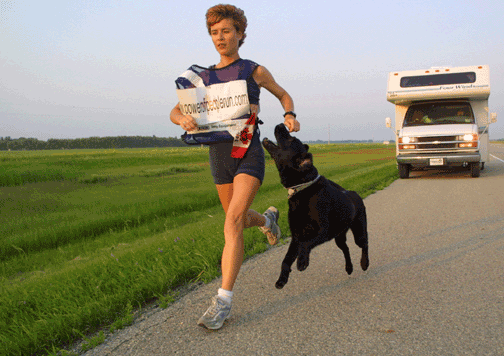Hope for Home Care
To meet Ann Keane is to recognize one's self-imposed limitations. How daunting a task to leave a life behind, kiss children goodbye, and decide, one small woman, to run across Canada? Across Canada, no less?! How many of us would be willing to make that sacrifice?
Incredibly, this woman found the courage, and is currently in the middle of an epic journey, in an effort to raise awareness and funds for home care and long-term care in Canada. She is also running to publicize the Hope Foundation of Alberta, a non-profit organization that is dedicated to understanding the role that hope plays in human life.
Ann began her journey on April 19th in Newfoundland. So far she has logged over 5000 km, passing through the Maritimes, Quebec, Ontario and Manitoba, and is now on her way through Saskatchewan. She hopes to be in British Columbia by late September.
Has it been difficult? You betcha! In her online diary, Ann has described her pitting edema, excruciating fatigue, black toenails, miserable blisters, the heat and constant battles with her arch nemeses, mosquitoes, or as she calls them, 'squiters.'
Why has she chosen to do it, and why has she chosen to raise funds for home care? Ann is a nurse with over twenty years experience in long-term care and home care. She is the former director of a home care program in Alberta, ran a 200 bed auxiliary hospital, and until the beginning of this run, was a member of provincial and national health care boards. She is also a woman frustrated and angered by the token government attention and funding to this important area. In her own words: "I was tired of being a warrior, and nothing ever changing."

According to a VHA Home Health care survey published in 2001, in Ontario 82% of the population is concerned about having access to home health care support as they age. Eighty-three percent of respondents to the same survey, with parents who were not currently receiving home care or institutional elder care services, fear a shortage of professional home care workers as the baby boom population retires.1
As a recent Census report shows, they have plenty to fear. Currently, over 13% of the population is 65 years of age or older, and the fastest-growing segment of the population is that aged 80 or older. The over 80 age group has increased by 41.2% between 1991 and 2001.2
In a 1988 US survey, older adults with long-term care needs stated a clear preference for home health care.3 However, currently only 4% of the national health care budget is spent on home care. Moreover, poor morale and recruitment problems are contributing to a shortage of home care workers, who are paid on average 30% less than are their colleagues who work in more formal facilities. They also face strict limitations with their time. How is one to preserve the dignity of an elderly client, when forced to enter an apartment, bathe the client and exit, all in the space of half an hour?
Does Ann believe in her cause? Absolutely. She is completely committed to the challenge, and is determined to make this journey count. That is not to say that she has not been discouraged or disappointed. She has periodically faced an upsetting lack of media interest in her cause. For better or worse, apparently there are many people biking or blading across the country to raise money or awareness for their chosen plight. While it is heartening that so many are willing to make these sacrifices, it makes it more difficult to raise funds for such an important cause. Especially when raising those funds involves running between 50 and 80 kilometres a day!
Regardless, she runs on. Ann is nothing if not persistent, and she clearly believes deeply in her cause. If nothing else, she knows that with this run she has given absolutely everything she can and has held nothing in reserve. She hopes that this will be enough to effect a change. Let us hope that she is right!
Ann Keane can be reached at her website at www.powerofpeoplerun.com. If you are interested in donating to her cause, you can click on the donation button on the website or phone or email her Donation Manager, John Duke at (780) 469-5094 or johnduke@telusplanet.net.
Sources
- VHA Home Healthcare. Ontarians worried about inadequate home care for seniors [Press release]. VHA Home Healthcare, April 2001, www.vha.ca/news/press.htm.
- Statistics Canada. Census Report. www.statcan.ca/english/IPS/Data/97F0024XIE2001001.htm
- National Survey of Caregivers: Summary of Findings. National Opinion Research Center Chicago, IL: October 1988.